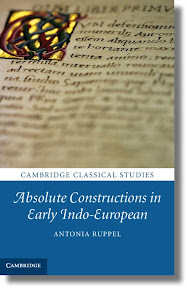Absolute Constructions in Early Indo-European
Ruppel, Antonia:
Absolute Constructions in Early Indo-European / Antonia Ruppel. - Cambridge [u.a.] : Cambridge University Press, 2013. - ca. 269 S. - (Cambridge Classical Studies)
ISBN 978-0-521-76762-0
£ 60,00
DDC: 415
Beschreibung
In the past, discussions of absolute constructions (ACs) have been limited by an imprecise understanding of what ACs are. By examining the nature and function of ACs and related constructions in Greek, Latin and Sanskrit, this new study arrives at a clear and simple definition of ACs. Focussing on the earliest attested material in each language, it highlights how AC usage differs between languages and offers explanations for these differences. Identifying the common core shared by all ACs, it suggests a starting-point and way by which they developed into Greek, Latin and Sanskrit. Further historical study reveals how ACs have been conceived of by grammarians, philologists and even Christian missionaries over the last two thousand years and how enduring misconceptions still affect our discussion of them today. All Sanskrit material is annotated in detail, making it accessible for classicists in particular and allowing a better understanding of ACs in Greek and Latin. [Verlagsinformation]
Inhalt
Acknowledgements. viii
List of abbreviations. x
Note on translations. xiv
1. The AC so far. 1
1.1 Why do we need another study of absolute constructions? 1
1.2 Prior research on ACs. 4
1.3 The scope of this study. 28
1.4 Summary of findings. 30
2. Early Greek. 33
2.1 Introduction. 33
2.2 The Genitive Absolute in Homer: an overview. 36
2.3 Homeric questions. 44
2.4 Future research? The Homeric GA in comparison with other means of grammatical subordination. 65
2.5 The GA in Hesiod. 68
2.6 The GA in the seventh and sixth centuries BC. 73
2.7 Absolute participles and related phenomena. 76
2.8 Conclusions. 79
3. Early Latin. 82
3.1 Introduction. 82
3.2 The Latin Ablative Absolute: an overview. 83
3.3 Delineating the AA semantically: absolute and other ablatives. 89
3.4 Delineating the AA syntactically: obligatory and dominant nominal qualifiers across Latin. 97
3.5 "Nominal" ACs in Latin. 108
3.6 ACs in Italic. 122
3.7 Conclusions. 123
4. The Sanskrit locative absolute and its syntactic surroundings. 127
4.1 Introduction. 127
4.2 Sanskrit literature: a brief sketch. 128
4.3 Some elements of Sanskrit grammar. 130
4.4 Supposedly absolute locatives in the Rigveda. 139
4.5 Actual Rigvedic LAs: expressions of natural time. 153
4.6 LAs in context. 156
4.7 The Sanskrit perspective. 159
4.8 The origins of the Western perspective. 165
4.9 Conclusions. 168
5. Proto-Indo-European roots of ACs. 172
5.1 Introduction. 172
5.2 Recapitulation: what makes ACs absolute? 173
5.3 Obligatory and apparently obligatory qualifiers: a cross-linguistic look. 176
5.4 The elements of the AC. 192
5.5 Proto-Indo-European. 206
5.6 From PIE into the daughter languages. 216
5.7 Absolute or not: an excursus. 222
5.8 Conclusions. 224
Appendix 1: Literature on ACs. 230
Appendix 2 ACs, potential ACs and constructions similar to ACs. 233
Bibliography. 236
Index of cited passages. 251
General index. 254
Autorin
ANTONIA RUPPEL is the Townsend Senior Lecturer in the Greek, Latin and Sanskrit Languages at Cornell University, New York. Profile page.
Quellen: Cambridge University Press; WorldCat; Amazon (UK); Library of Congress
Bildquelle: Cambridge University Press
Bibliographie: [1]
References
- (2013). Absolute Constructions in Early Indo-European. Cambridge Classical Studies.

